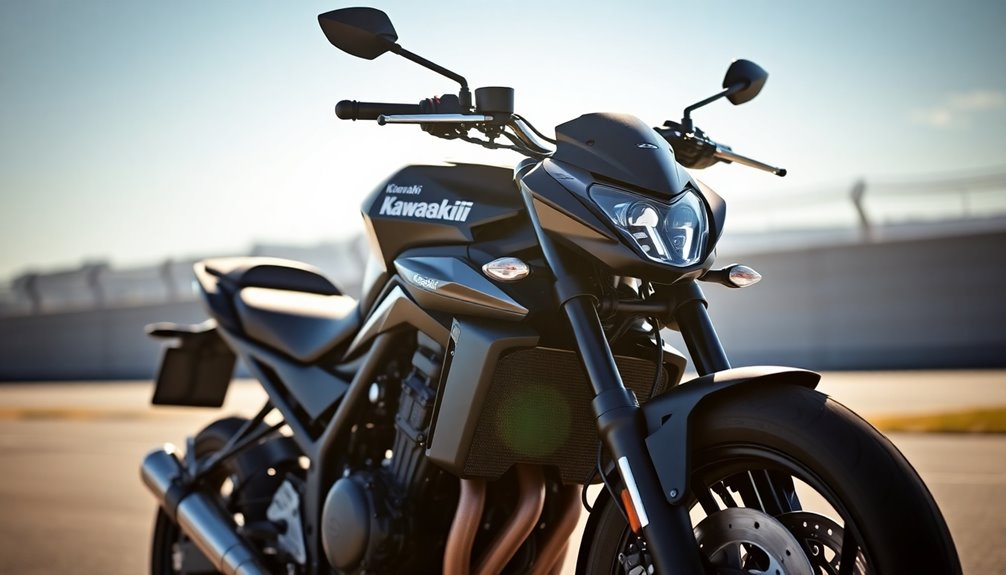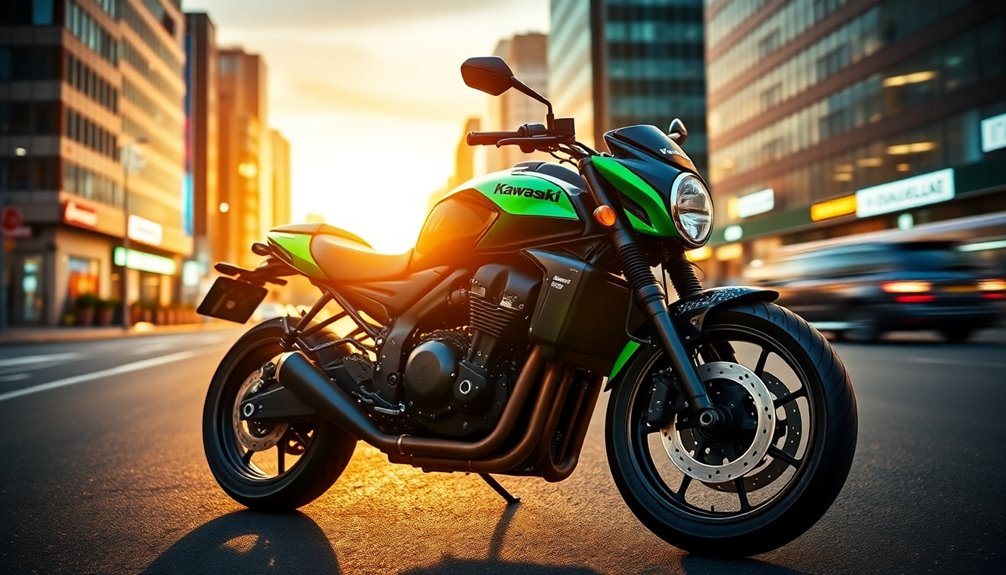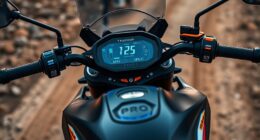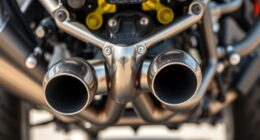Kawasaki’s idle control techniques involve sophisticated fuel injection systems that precisely adjust fuel delivery based on engine conditions, ensuring stable RPMs at idle. They also use electronic mechanisms, like sensors and automatic throttle adjustments, to stabilize engine speed during cold starts and load changes. Proper maintenance, such as cleaning filters and checking throttle operation, keeps these systems functioning as effectively as possible. To discover how these features work together for smooth operation, keep exploring the details.
Key Takeaways
- Kawasaki uses advanced fuel injection systems to maintain a stable idle by precisely adjusting fuel delivery based on engine conditions.
- Throttle adjustment and control ensure smooth engine response and prevent fluctuations during idle.
- Electronic idle speed control mechanisms automatically regulate throttle and fuel flow using sensor data.
- The system manages cold starts and sudden load changes to keep idle stable and prevent stalling.
- Regular maintenance of air filters, fuel injectors, and throttle components supports optimal idle control performance.
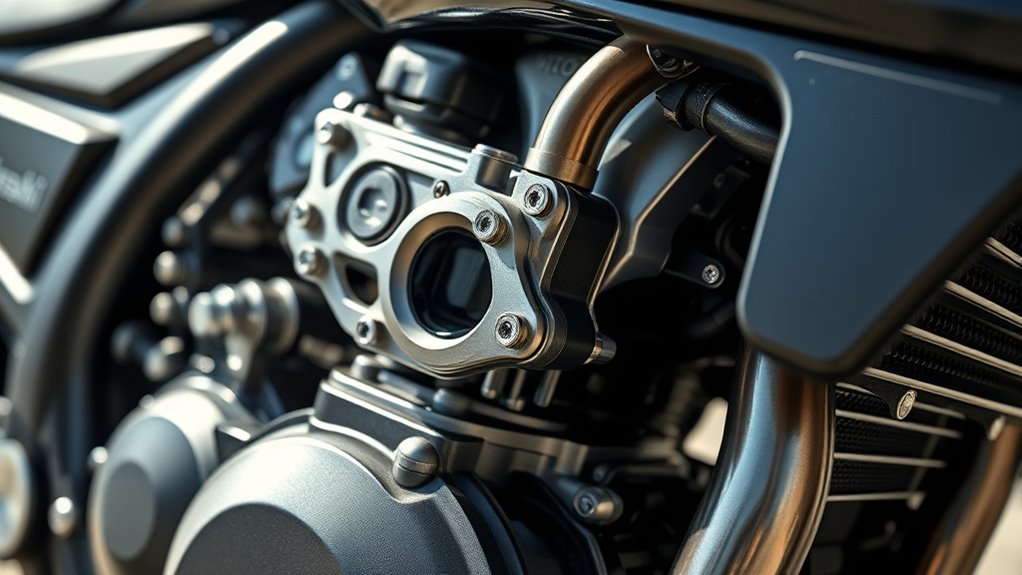
Kawasaki’s idle control techniques are designed to guarantee your engine runs smoothly and efficiently at all times. Whether you’re starting your bike on a chilly morning or riding through variable terrain, maintaining a stable idle ensures your motorcycle performs reliably. One of the key methods Kawasaki employs involves advanced fuel injection systems. These systems are precisely calibrated to deliver the right amount of fuel at all engine speeds, including idle. By monitoring engine conditions constantly, the fuel injection system adjusts the fuel flow to keep your engine running smoothly, reducing stalling and rough idling issues. This technology provides a consistent fuel-air mixture, which is vital for stable idling, especially under changing load conditions or temperature fluctuations.
Alongside fuel injection, Kawasaki emphasizes proper throttle adjustment as a fundamental part of idle control. Throttle control isn’t just about twisting the grip; it involves fine-tuning the throttle cable or electronic throttle system to guarantee the engine receives the correct input at idle. If the throttle is too tight or too loose, it can cause irregular engine speeds, leading to stalls or uneven idling. Kawasaki recommends periodic inspection and adjustment of the throttle cable or electronic sensors to maintain ideal idle speed. This adjustment helps your engine respond accurately to your control inputs and maintains a steady RPM, preventing fluctuations that could compromise your ride or cause engine stress.
Kawasaki also integrates electronic idle speed control mechanisms that automatically adjust throttle valves or fuel delivery based on sensor inputs. These systems continually monitor engine temperature, load, and other parameters to keep the RPM stable without your intervention. When you start your bike, the idle control system kicks in to warm up the engine gradually, preventing stalls and ensuring a smooth transition from cold start to normal operation. During your ride, if you encounter a sudden load change—like going uphill or engaging the clutch—these systems automatically adjust the throttle to maintain a consistent idle speed, enhancing your overall riding experience. Proper maintenance, including keeping the fuel injection components clean and in good condition, is essential to ensure these systems work effectively.
Regular maintenance is essential to keep these controls functioning at their best. Cleaning or replacing air filters, checking fuel injection components, and ensuring the throttle operates freely all contribute to ideal idle control. Kawasaki’s focus on integrating fuel injection and precise throttle adjustments simplifies this process, making it easier for you to enjoy a smooth, reliable ride. By paying attention to these aspects, you can guarantee your Kawasaki engine remains responsive, efficient, and trouble-free, no matter the riding conditions.
Frequently Asked Questions
How Do Environmental Factors Affect Kawasaki’s Idle Control?
Environmental factors like air temperature and altitude effects directly impact Kawasaki’s idle control. When air temperature drops, your engine may struggle to maintain a steady idle, so adjustments are needed. At higher altitudes, the thinner air reduces engine power, causing idle fluctuations. You should monitor these conditions and tweak idle settings accordingly to keep your Kawasaki running smoothly. Understanding these influences helps you maintain ideal engine performance in various environments.
Can Idle Control Techniques Vary Between Kawasaki Models?
Yes, your Kawasaki’s idle control techniques can differ between models. Model variations often bring unique features, so sensor calibration may be tailored for each. You’ll find that different models respond differently to throttle, airflow, and environmental factors, requiring specific adjustments. By understanding these distinctions, you guarantee smooth, steady idling. So, check your model’s manual for precise sensor calibration tips and keep your Kawasaki purring perfectly, no matter the model.
What Maintenance Is Required for Optimal Idle Control?
You need to regularly inspect and maintain your idle system for ideal performance. This includes cleaning the carburetor to prevent buildup that can disrupt idle control. Also, check for vacuum leaks or worn parts in the idle system, and replace any faulty components. Keeping your carburetor clean and ensuring the idle system is free of debris helps maintain a steady, smooth idle, extending your motorcycle’s lifespan and improving ride quality.
Are There Aftermarket Parts That Improve Kawasaki’s Idle Performance?
You might think aftermarket upgrades can substantially boost Kawasaki’s idle performance, but many won’t make a noticeable difference without proper idle adjustment. Some aftermarket parts, like high-performance air filters or carburetor kits, can help, but they often require precise tuning. Before installing any aftermarket parts, make sure you’ve optimized your idle adjustment. Proper tuning and quality components are key to achieving smoother idle, so choose wisely and consider professional help if needed.
How Does Kawasaki’s Idle Control System Impact Fuel Efficiency?
Kawasaki’s idle control system directly impacts your fuel efficiency by optimizing engine calibration and throttle response at idle. When the system functions properly, it maintains smooth engine operation, reducing unnecessary fuel consumption. If the system is faulty or improperly calibrated, you might notice increased fuel use and rough idling. Regular maintenance and adjustments help guarantee your engine runs efficiently, maximizing fuel savings and enhancing overall performance.
Conclusion
By mastering Kawasaki’s idle control techniques, you become the steady captain steering through a calm, clear lake. You fine-tune each adjustment like a skilled artist, painting a smooth, flawless ride. With this knowledge, your engine hums like a well-orchestrated symphony, effortlessly balancing power and efficiency. So, take the wheel with confidence, knowing you hold the brush to craft a ride that’s as smooth as glass and as reliable as the sunrise.



